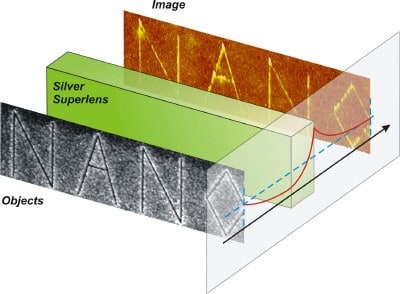Physicists in the US have made an optical superlens from a thin layer of silver. The lens has a negative refractive index and can be used to image structures with a resolution that is about one sixth the wavelength of light -- thus overcoming the so-called diffraction limit (N Fang et al. 2005 Science 308 534). Xiang Zhang and colleagues at the University of California at Berkeley say that the lens could have many applications, such as imaging nano-scale objects with light.

Conventional, positive-refractive-index lenses create images by capturing the light waves emitted by an object and then bending them. However, objects also emit “evanescent” waves that contain a lot of information at very small scales about the object. These waves are much harder to measure because they decay exponentially and never reach the image plane — a threshold in optics known as the diffraction limit.
In 2000, John Pendry of Imperial College in London suggested that a material with a negative refractive index — that is, one that bends light in the opposite direction to an ordinary material — could capture and “refocus” these evanescent waves. This idea of a perfect lens or “superlens” came over 30 years after Russian physicist Victor Veselago first speculated that negative index materials could exist. In such a superlens, electromagnetic waves that reach the surface of a negative refraction lens excite a collective movement of surface waves, such as electric oscillations — also known as “surface plasmons”. This process enhances and recovers the evanescent waves.
In 2003, Zhang’s group showed that optical evanescent waves could indeed be enhanced as they passed through a silver superlens. Now they have taken this work one step further and have imaged objects as small as 40-nm across with their superlens, which is just 35-nm thick (see figure). In contrast, current optical microscopes can only resolve objects down to around 400-nm, which is about one tenth the diameter of a red blood cell.
“Our work provides a new imaging method that can beat the optical diffraction limit and that has tremendous potential to revolutionize a wide range of technologies,” says Zhang. These include detailed biomedical imaging in real-time and in vivo, optical lithography to make higher density electronic circuits and faster fibre-optic communications.
“This paper represents a very critical step forward,” David Smith of Duke University in the US told PhysicsWeb. “It provides confirmation of Pendry’s original conjecture that a negative refractive element can focus near-fields and demonstrates clearly that evanescent refocusing occurs to create an image.”
“The work is a remarkable accomplishment,” says Pendry. “Although superlensing has previously been demonstrated at microwave frequencies, this is the first true super resolution at optical frequencies — where the greatest rewards in terms of applications are to be had. I am extremely pleased with this result.”



